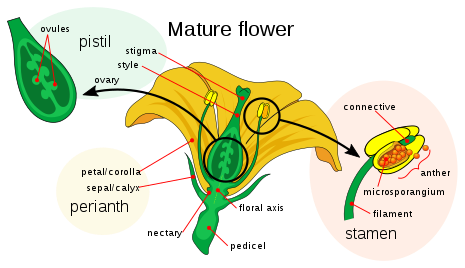CBSE Class 11 Biology Chapter 6 Revision Notes Part 2
Chapter 6: Anatomy of Flowering Plants Revision Notes Part 2
The detailed female anatomy of angiosperms includes the pistils, whereas the detailed male anatomy of angiosperms includes stamens. The anatomy of a flowering plant also includes the anatomy of angiosperm leaves. Each leaf consists of the blade, petiole, and stipules. The leaf is made up of a variety of cells that form different types of tissues, including the epidermis and mesophyll layers. Stomata and guard cells are are located beneath the surface of the leaf.
The Detailed Female Anatomy of an Angiosperm
Within the female reproductive system of angiosperms are the pistils.
The pistil consists of:
- The stigma – which receives the pollen during fertilization
- The Style – which carries the pollen to the ovary
- The ovary – which is the primary female reproductive organ
- The ovule – that is the reproductive cell involved in fertilization with the male gamete
When a male gamete, that is, the pollen sticks to the stigma, it is taken down through the style, wherein it goes to the ovary where an egg is present for fertilization.
The Detailed Male Anatomy of an Angiosperm
The male reproductive systems are the stamens. On the end of the stamen is the anther, where pollen is made. The filament is the tube leading up to the anther, though its function is purely mechanical, supporting the anther. When the anther makes the pollen, it is carried away for fertilization through pollination.
The Anatomy of the Leaves of an Angiosperm
Main external leaf features include the leaf blade (apex, margin, midrib, veins, and base), petiole, and stipules:
-
Petiole – a thin stalk that attaches the leaf to a stem
-
Stipules – leaf-like structures at the leaf base
-
Blade – broad portion of a leaf
→ Apex – leaf tip
→ Margin – leaf edge boundary area. Margins can be smooth, jagged (toothed), lobed, or parted
→ Midrib – central main vein arising from secondary veins
→ Veins – vascular tissue bundles that support the leaf and transport nutrients
→ Base – an area of the leaf that connects the blade to the petiole
The cells within a leaf make up a layer of tissues. These tissues include a mesophyll layer that is enclosed between two layers of the epidermis. The vascular bundle of the leaves is enclosed within the mesophyll layer.
1. Epidermis: The outermost leaf layer is called the epidermis. The epidermis secretes the cuticle, a waxy coating that helps the plant retain water. The plant leaves also contain guard cells that manage the gas exchange. Guard cells control the stomata (singular stoma), which allows plants to undertake the gaseous exchange of water vapor, oxygen, and carbon dioxide as needed.
2. Mesophyll: The mesophyll tissue is composed of palisade mesophyll and spongy mesophyll. Palisade mesophyll contains column-shaped cells with spaces in between the cells. Most plant chloroplasts are found in this layer of palisade mesophyll.
Chloroplasts are organelles that contain chlorophyll, which is a green pigment that absorbs energy from sunlight to undertake the process of photosynthesis. The spongy mesophyll is located directly below the palisade mesophyll and is composed of loosely placed cells to allow for easy exchange of oxygen. The leaf vascular tissue consisting of xylem and phloem is found in the spongy mesophyll.
Guard Cells and the Stomata
The two guard cells are bean-shaped cells that surround the stomata. Water is released through them into the surroundings, and vice versa, in the form of water vapor. They also play an imperative role in gaseous exchange in and out of plant leaves by controlling the opening and closing of pores known as stomata.
Sources:
Anatomy of Flowering Plants. https://ncert.nic.in/textbook.php Accessed 18 Dec, 2021.
]]>


